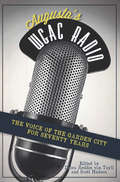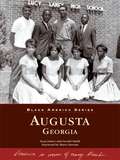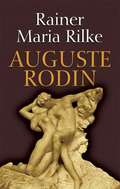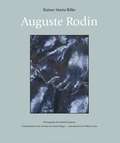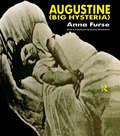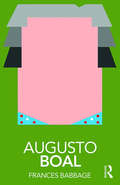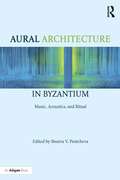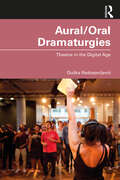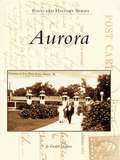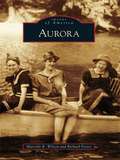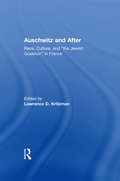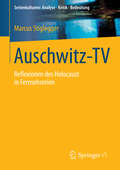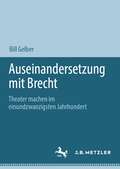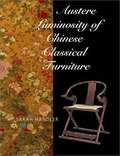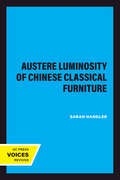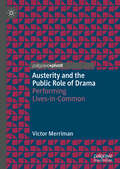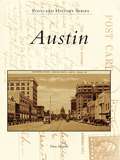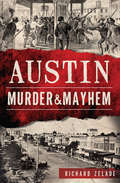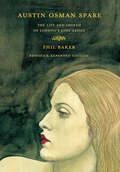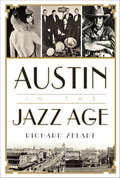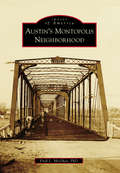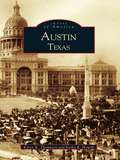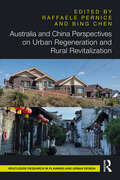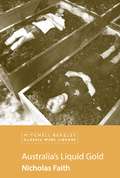- Table View
- List View
Augusta's WGAC Radio: The Voice of the Garden City for Seventy Years
by Debra Reddin van Tuyll Scott HudsonWGAC is the No. 1-rated radio station in Augusta. It has weathered the transition in American radio from local stations with local programming to corporately owned stations that feature syndicated programming, and it has been able to do so without giving up its local character. As a news-talk radio station today, WGAC is the first place most Augustans go to find out what is happening nationally and locally, and its morning drive-time and afternoon drive-time show hosts and news personnel are some of the most beloved and respected media figures in Augusta. This book will trace the history of this community landmark from its infancy to its status today as a community institution. It will highlight the people who have created the programming for which WGAC is known and also the people like James Brown who have used the station to launch important careers. The book will also discuss Fuqua's broadcasting technology innovations such as advances in acoustics engineering and early television technology. The history will also cover the station's decades-long support of the Master's Golf Tournament, which has led to it becoming the official radio station of the Master's.
Augusta, Georgia (Black America Series)
by Sean Joiner Marva Stewart Gerald SmithFilled with remarkable vintage photographs, Black America: Augusta, Georgia captures the essence of the African-American heritage in this historic Southern community. The Garden City has produced a wide variety of intellectual and political pioneers, including a handful of educators who were instrumental in the pivotal Brown versus Board of Education case. Within the pages of this volume, their stories unfold.
Auguste Rodin (Dover Fine Art, History of Art)
by Rainer Maria RilkeDuring the early 1900s, the great German poet lived and worked in Paris with Auguste Rodin. In a work as revealing of its author as it is of his famous subject, Rainer Maria Rilke examines Rodin's life and work, and explains the often elusive connection between the creative forces that drive timeless literature and great art.Rilke served for several years as Rodin's secretary — living in the sculptor's workshops, watching the shaping of his creations, and discussing his views and ideas. Written in 1903 and 1907, these essays about the master's work and development as an artist mark Rilke's entry into the world of letters. Rodin himself paid the poet the ultimate tribute, declaring these meditations the supreme interpretation of his work. This excellent translation, complemented by 33 illustrations, will fascinate students of literature, philosophy, and art history.
Auguste Rodin (Lives Of The Artists Ser.)
by Rainer Maria Rilke William H. Gass Michael Eastman Daniel SlagerSculptor Auguste Rodin was fortunate to have his secretary Rainer Maria Rilke, one of the most sensitive poets of our time. These two pieces discussing Rodin¢s work and development as an artist are as revealing of Rilke as they are of his subject. Written in 1902 and 1907, these essays mark the entry of the poet into the world of letters. Rilke¢s description of Rodin reveals the profound psychic connection between the two great artists, both masters of giving visible life to the invisible. Michael Eastman¢ evocative photographs of Rodin¢s sculptures shed light on both Rodin¢s art and Rilke¢s thoughts and catapult them into the 21st century.
Augustine (Contemporary Theatre Studies #Vol. 20)
by Anna FurseFirst Published in 1997. Routledge is an imprint of Taylor & Francis, an informa company.
Augusto Boal (Routledge Performance Practitioners)
by Frances BabbageThis newly-updated volume looks at the scope of Augusto Boal's career from his early work as a playwright and director in Sao Paulo in the 1950s, to the development of his ground-breaking manifesto in the 1970s for a 'Theatre of the Oppressed'. Offering fascinating reading for anyone interested in the role that theatre can play in stimulating social and personal change, this useful study includes: a biographical and historical overview of Boal's career as theatre practitioner and director an in-depth analysis of Boal's classic text on radical theatre an exploration of training and production techniques practical guidance to Boal's workshop methods This is an essential introduction to the work of a practitioner who has had a tremendous impact on contemporary theatre. As a first step towards critical understanding, and as an initial exploration before going on to further, primary research, Routledge Performance Practitioners are unbeatable value for today’s student.
Aural Architecture in Byzantium: Music, Acoustics, and Ritual
by Bissera V. PentchevaEmerging from the challenge to reconstruct sonic and spatial experiences of the deep past, this multidisciplinary collection of ten essays explores the intersection of liturgy, acoustics, and art in the churches of Constantinople, Jerusalem, Rome and Armenia, and reflects on the role digital technology can play in re-creating aspects of the sensually rich performance of the divine word. Engaging the material fabric of the buildings in relationship to the liturgical ritual, the book studies the structure of the rite, revealing the important role chant plays in it, and confronts both the acoustics of the physical spaces and the hermeneutic system of reception of the religious services. By then drawing on audio software modelling tools in order to reproduce some of the visual and aural aspects of these multi-sensory public rituals, it inaugurates a synthetic approach to the study of the premodern sacred space, which bridges humanities with exact sciences. The result is a rich contribution to the growing discipline of sound studies and an innovative convergence of the medieval and the digital.
Aural/Oral Dramaturgies: Theatre in the Digital Age
by Duška RadosavljevićAural/Oral Dramaturgies: Theatre in the Digital Age focuses on the ‘aural turn’ in contemporary theatre-making, examining a number of seemingly disparate trends that foreground speech and sound -- ‘post-verbatim’ theatre, 'amplified storytelling' (works using microphones and headphones), and ‘gig theatre’ that incorporates live music performance. Its main argument is that the dramaturgical underpinnings of these works contribute to an understanding of theatre as an extra-literary activity, greater than the centrality of the script that traditionally dominated many historical discussions. This quality is usually expressed in terms of the corporeality in dance and physical theatre, but the aural/oral turn gives an alternative viewpoint on the interplay between text and performance. The book's case studies draw on the ways in which a range of theatre companies engage with the dramaturgy of speech and sound in their work. It is further accompanied by a specially curated collection of digital resources, including interviews, conversations, and presentations from artists and academics. This is a key text for scholars, students, and practitioners of contemporary performance, and anyone working with dramaturgies of orality and aurality in today’s performance environment.
Aurora
by Jo Fredell HigginsCovered wagons brought a wave of migration to northern Illinois in the mid-1830s. On April 1, 1834, the first permanent white settlers, Joseph McCarthy and two assistants, paddled up the Fox River. The vicinity was known as Waubonsie's Village at that time. They built a log cabin, a dam across the Fox, and eventually a sawmill. The village had about 400 Native Americans who bartered fish for bread and tobacco. For almost 175 years now, growth has been steady and sure, and the city of Aurora is the second-largest metropolitan area in Illinois. Aurora is home to honorable civic institutions, excellent education, and a multicultural and energetic population.
Aurora (Images of America)
by Marcelle R. Wilson Richard FetzerLocated in northeastern Ohio, Aurora began as part of the Connecticut Western Reserve and drew many of its first settlers from New England. The city was founded in 1799, with its residents making their living from hunting, farming, and milling. As settlers cleared the land, planted their crops, and raised their animals, they retained their New England heritage, reflected in the many "century homes" found in the town. The area remained largely rural until the mid-20th century, with dairy farmers shipping cheese all over the country and to Europe from 1850 to 1910. Aurora has served as a bedroom community from the 1900s to the 1960s, and Geauga Lake has been a vacation destination since the 1860s. Currently Aurora retains much of its rural charm with Audubon lands, nature reserves, and many lakes and wetlands.
Auschwitz and After: Race, Culture, and "the Jewish Question" in France
by Lawrence D. KritzmanBeginning with Marcel Ophus's documentary The Sorrow and the Pity (1970) there has been an attempt to question the idea of a totally unified, courageous and resistant wartime France. Even more startling have been the increasingly shocking revelations that the politics of collaboration were a mere extension of a deep-seated French anti-semitic tradition. In the shadow of these developments French writers and philosophers today are reflecting on the meaning of Jewish identity in the contemporary world. Auschwitz and After analyses for the first time how the memory of Auschwitz and the collaboration continue to haunt the French. These critical evaluations are accompianed by provocative essays on the "jewish Question" and the politics of race as they have been studied by writers, historians, philosophers and film makers in postwar France.
Auschwitz-TV: Reflexionen des Holocaust in Fernsehserien (Serienkulturen: Analyse – Kritik – Bedeutung)
by Marcus StigleggerDie Miniserie Holocaust, deren Ausstrahlung 1978 in den USA ca. 100 Millionen Zuschauer verfolgten, erreichte in West-Deutschland ein Jahr später etwa ein Publikum von 16 Millionen. Der Band leitet die Entstehung von Marvin J. Chomskys Holocaust aus der Tradition der TV-Familiensagas (z. B. Roots) her und untersucht nah am Material, welches Bild der historischen Ereignisse diese Fernsehserie und spätere Produktionen inszenieren. Zudem wird die Auswirkung der Serie bis heute verfolgt und veranschaulicht.
Auseinandersetzung mit Brecht: Theater machen im einundzwanzigsten Jahrhundert
by Bill GelberDieses Buch ist ein Plädoyer für Bertolt Brechts anhaltende Bedeutung in einer Zeit, in der die Ereignisse des 21. Jahrhunderts nach einer studierten Art und Weise schreien, Theater für den sozialen Wandel zu produzieren. Hier wird ein einzigartiger Schritt-für-Schritt-Prozess für die Umsetzung von Brechts Arbeitsweisen auf der Bühne vorgestellt, wobei die 2015 an der Texas Tech University entstandene Produktion von Brechts "Mutter Courage und ihre Kinder" als Modell für die Erkundung dient. Besondere Brecht-Konzepte - das Epos, die Verfremdung, die Fabel, der Gestus, die Historisierung, die Literarisierung, das "Nicht...aber", das Arrangement und die Trennung der Elemente - werden erläutert und auf Szenen und Stücke angewendet. Brechts komplizierte Beziehung zu Konstantin Stanislawski wird auch in Bezug auf ihre unterschiedlichen Ansichten über das Schauspiel erforscht. Für Theaterpraktiker und -pädagogen ist dieser Band eine Aufzeichnung des pädagogischen Engagements, eine empirische Studie von Brechts Werk in der Aufführung an einer höheren Bildungseinrichtung mit Studenten und Absolventen.
Austere Luminosity of Chinese Classical Furniture
by Sarah HandlerAustere Luminosity will be the book on Chinese classical furniture. A sumptuous coffee table book with impeccable scholarship, Sarah Handler's expertise will serve as the primary resource for scholars and collectors of Chinese classical furniture for years.
Austere Luminosity of Chinese Classical Furniture
by Sarah HandlerChinese classical furniture is esteemed throughout the world for its beauty, functionalism, and influence on contemporary design aesthetics. Sarah Handler's stunningly illustrated volume traces Chinese hardwood furniture from its earliest origins in the Shang dynasty (c. 1500 to c. 1050 B.C.) to the present. She offers a fascinating and poetic view of Chinese furniture as functional sculpture, a fine art alongside the other Chinese arts of calligraphy, architecture, painting, and literature. Handler, a widely respected scholar of Chinese furniture, uses her knowledge of Chinese social, political, and economic history to provide a backdrop for understanding the many nuances of this art form. Drawing on literary and visual evidence from excavated materials, written texts, paintings, prints, and engravings, she discusses how people lived, their notions of hierarchy, and their perceptions of space. Her descriptions of historical developments, such as the shift from mats to chairs, evoke the psychological and sociological ramifications. The invention of a distinctive way to support and contain people and things within the household is one of China's singular contributions, says Handler. With more than three hundred exquisite illustrations, many in color, Handler's comprehensive study reveals "the magical totality of Chinese classical furniture, from its rich surfaces and shrewd proportions down to the austere soul of art that resides in the hardwood interiors." Austere Luminosity recognizes Chinese classical furniture as one of China's premier arts, unique in the furniture traditions of the world.
Austerity and the Public Role of Drama: Performing Lives-in-Common
by Victor MerrimanThis book asks what, if any, public role drama might play under Project Austerity – an intensification phase of contemporary liberal political economy. It investigates the erosion of public life in liberal democracies, and critiques the attention economy of deficit culture, by which austerity erodes life-in-common in favour of narcissistic performances of life-in-public. It argues for a social order committed to human flourishing and deliberative democracy, as a counterweight to the political economy of austerity. It demonstrates, using examples from England, Ireland, Italy, and the USA, that drama and the academy pursue shared humane concerns; the one, a critical art form, the other, a social enabler of critical thought and progressive ideas. A need for dialogue with emergent forms of collective consciousness, new democratic practices and institutions, shapes a manifesto for critical performance, which invites universities and cultural workers to join other social actors in imagining and enabling ethical lives-in-common.
Austin
by Don MartinAs the capital of Texas, Austin has a long and colorful history. The first residents were nomadic Native Americans who camped here as long ago as 9000 BC because of the area's beauty, the clear Colorado River, and the wildlife. These are the very same things that attract people to Austin today. Originally called Waterloo, Austin has grown from a tiny town on the edge of the western frontier in 1839 into the capital city it is today. The University of Texas lent prestige, the state government erected buildings, the railroads came to town, and Congress Avenue--the "main street" of Texas--filled with thriving businesses.
Austin Murder & Mayhem (Murder And Mayhem Ser.)
by Richard ZeladeAustin&’s past is as weird as its present—including murderous neighbors, deadly political antics, and a serial killer suspected to be Jack the Ripper. Beneath Austin&’s shiny veneer lies a dark past, filled with murder, lechery and deceit. Legislators, lawmen and lawyers killed, robbed and lied just as well and just as often as the drifters and grifters preying on newcomers. The nation&’s first known serial killer made his debut in Austin in the form of the Servant Girl Annihilator, who is still rumored to be Jack the Ripper. After the Willis brothers murdered their neighbors over rumored buried gold, a lynch mob hanged the boys from live oaks on present-day Sixth Street. Freshman representative Louis Franke died after he was robbed and beaten on the steps of the statehouse. Author Richard Zelade delivers a fascinating look at the seedier side of Austin history. Includes photos!
Austin Osman Spare, revised edition: The Life and Legend of London's Lost Artist
by Phil BakerA revised edition of Phil Baker&’s critically lauded biography of artist and occultist, Austin Osman Spare.London has harbored many curious characters, but few more curious than the artist and visionary Austin Osman Spare (1886–1956). A controversial enfant terrible of the Edwardian art world, the young Spare was hailed as a genius and a new Aubrey Beardsley, while George Bernard Shaw reportedly said &“Spare&’s medicine is too strong for the average man.&” But Spare was never made for worldly success and he went underground, falling out of the gallery system to live in poverty and obscurity south of the river. Absorbed in occultism and sorcery, voyaging into inner dimensions, and surrounding himself with cats and familiar spirits, he continued to produce extraordinary art while developing a magical philosophy of pleasure, obsession, and the subjective nature of reality. Today Spare is both forgotten and famous, a cult figure whose modest life has been much mythologized since his death. This groundbreaking biographical study offers wide-ranging insights into Spare&’s art, mind and world, reconnecting him with the art history that ignored him and exploring his parallel London; a bygone place of pub pianists, wealthy alchemists, and monstrous owls. This richly readable and illuminating biography takes us deep into the strange inner world that this most enigmatic of artists inhabited, shedding new light while allowing just a few shadowy corners to flourish unspoiled. Revised, updated, and with a new afterword by the author, this is the definitive edition of Phil Baker&’s critically lauded Austin Osman Spare: The Life and Legend of London&’s Lost Artist.
Austin in the Jazz Age
by Richard ZeladeThough renowned, Austin's contemporary music scene pales in comparison with the explosion of creative talent the city spawned during the Jazz Age. Dozens of musicians who started out in the capital city attained national and international fame--but music was just one form of artistic expression that marked that time of upheaval. World War I's death and destruction bred a vehement rejection of the status quo. In its place, an enthusiastic adherence to life lived without question or consequence took root. The sentiment found fertile soil in Austin, with the University of Texas at the epicenter. Students indulged in the debauchery that typified the era, scandalizing Austin and Texas at large as they introduced a freewheeling, individualistic attitude that now defines the city. Join author Richard Zelade in a raucous investigation of the day and its most outstanding and outlandish characters.
Austin's Montopolis Neighborhood
by Fred L. McgheeMontopolis is a multiethnic neighborhood located approximately four miles southeast of downtown Austin. The area was long visited and occasionally occupied by various Texas Indian nations; the first documented European or American to settle here was Jessie C. Tannehill, who in 1830 built a cabin and townsite and gave the new community its pretentious name. Instead of establishing a permanent presence in Montopolis, however, subsequent European colonizers looked a few miles upriver to the new settlement of Waterloo, later to be called Austin. Rural and sparsely populated, the remainder of the 19th century saw the Montopolis area used primarily for plantation agriculture. In the 1920s, succeeding waves of Mexican migrants helped establish the modern neighborhood that exists today. Between the 1950s and 1970s, the City of Austin annexed Montopolis, although the area retains much of its rural character.
Austin, Texas
by Kathy R. Howell Karen R. ThompsonWhen General Sam Houston's Texas army defeated Mexican General Santa Anna at the Battle of San Jacinto on April 21, 1836, the Republic of Texas was born. Austin, located on the banks of the Colorado River, was laid out as the capital city in 1839, and has remained the capital since statehood in 1846. Featured here in over 200 vintage photographs is the history of this independent city, and the people who made it what it is today. Land agent Stephen F. Austin brought the first Anglo settlers to the Spanish territory in 1821 and guided them until independence in 1836. Seen here are the images that capture the spirit of those original pioneers and their achievements, including the French Legation, the construction of the capitol, and the Texas governor's mansion, the oldest governor's residence west of the Mississippi. Also pictured are the familiar faces of Austin's long history, including Austin's first mayor, Edwin Waller, and past governor Alan Shivers.
Australia and China Perspectives on Urban Regeneration and Rural Revitalization (Routledge Research in Planning and Urban Design)
by Bing Chen Raffaele PerniceThis edited volume reviews important contemporary issues through relevant case studies and research in China and Australia, such as the challenges posed by climate change, the development of eco-urban design, research on sustainable habitats and the relationship between ecology, green architecture and city regeneration, as well as, in general, the future of the city in the new millennium.The authors represent a broad selection of international experts, young scholars and established academics who discuss themes related to urban–rural destruction and economic and spatial regeneration techniques, the sustainable reconversion of natural landscapes and eco-urban design in the context of the current evolution of architectural and urbanism practice. The book aims to explain the conditions in which the contemporary debate about urban regeneration and rural revitalisation has developed in Australia and China, presented by different theoretical and methodological perspectives. It also provides a multifaceted and critical analysis of relevant case studies and urban experiences in Australia and China, focusing on environmental disruption, resized urban interventions and the need for more efficient and sustainable forms of regeneration and urban renewal practice in urban–rural contexts.This book will be an invaluable resource for architects, planners, architectural and urban historians, geographers, and scholars interested in modern Australian and Chinese architecture and urbanism.
Australia's Liquid Gold
by Nicholas FaithHow did Australia achieve such phenomenal success in its wine business? Historian and critically acclaimed wine writer Nicholas Faith gives an indepth account of the growth and international boom of Australia's wine industry and describes how these wines have risen to the point of becoming the world's number one choice. This is the first book to chart the success story of Austalia's wine trade.
Australia's Sweetheart: The amazing story of forgotten Hollywood star Mary Maguire
by Michael AdamsThis is the fascinating story of Mary Maguire, a 1930s Australian ingenue who sailed for Hollywood and a fabulous life, only to have her career cut short by scandal and tragedy. Packed with celebrity, history and gossip, AUSTRALIA'S SWEETHEART is perfect for readers of SHEILA and THE RIVIERA SET.Mary Maguire was Australia's first teenage movie star and she captivated Hollywood in the mid 1930s. Mary lived on three continents and was celebrated in Melbourne, Brisbane, Sydney, Los Angeles and London. Her life was lived in parallel with seminal incidents of the twentieth century: the Spanish Flu; the Great Depression; the Bodyline series; Australia's early radio, talkies and aviation; Hollywood's Golden Era; the British aristocracy's embrace of European fascism; London's Blitz; and post-war American culture and politics. Mary knew everyone, from Douglas Jardine, Don Bradman, Errol Flynn and Ronald Reagan, to William Randolph Hearst, Maureen O'Sullivan, Judy Garland and Queen Elizabeth II.AUSTRALIA'S SWEETHEART in an irresistible never-before-told story that captures the glamour of Hollywood and the turbulent times of the twentieth century, with a young woman at its centre. If you loved THE AMAZING MRS LIVESEY, Robert Wainwright's SHEILA and MISS MURIEL MATTERS, you will adore AUSTRALIA'S SWEETHEART.
